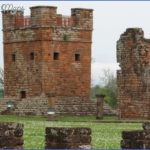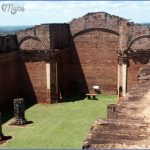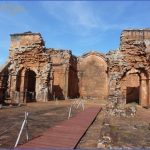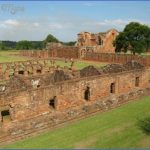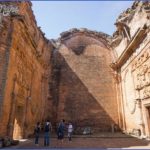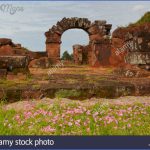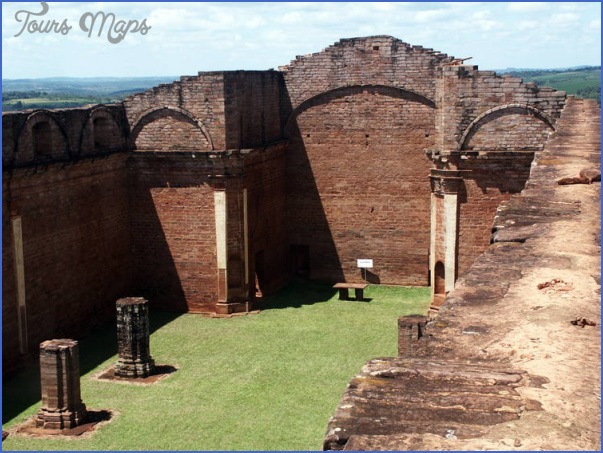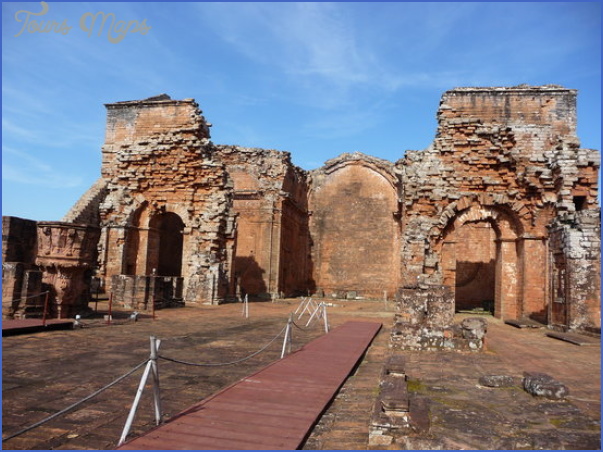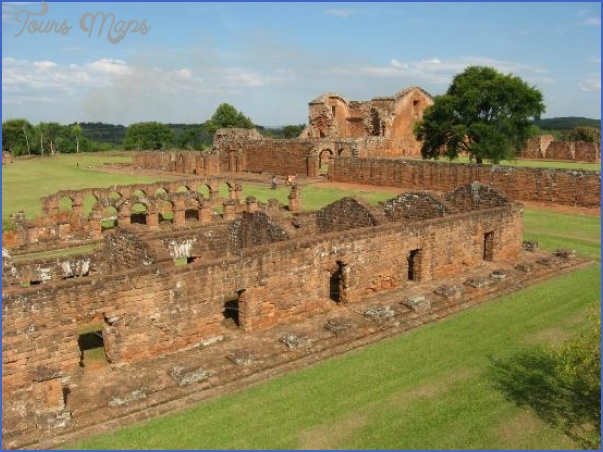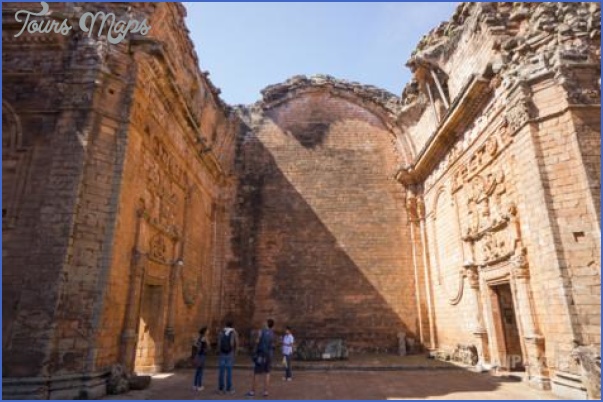Founded in 1706 by Juan de Anaya, the mission of Santisima Trinidad del Parana (usually shortened to Trinidad) was the second to last of the thirty Jesuit missions to be built. Founded with overflow from the mission of San Carlos de Borrome, construction began in 1712. In fact, the mission was still under construction when Jesuits were expelled from Paraguay in 1767. At its peak Trinidad was home to over 4,000 indigenous, all under the supervision of just two to three Jesuit priests.
Of all the missions in Paraguay, Trinidad has the most remaining structures – there are ruins of almost all of the elements that made up a typical Jesuit mission. Visitors to the mission enter onto the exceptionally large main plaza, surrounded on all sides by the indigenous dwellings. The twenty-one
stone buildings housed between six and eight families each. The buildings were lined with a long corridor, the arches of which still remain. Visitors to any of the Jesuit towns in Misiones will easily be able to picture these dwellings as they once were – most towns retain a significant portion of their mission’s indigenous dwellings. To the right (if facing the main church) is the mission’s first church. Unlike most missions there were two churches in Trinidad, the first, referred to as the iglesia primitiva smaller in size than the second, referred to as the iglesia mayor. Beside this smaller church is the square fort-like watch tower.
Trinidad’s main, larger church is the mission’s most impressive and evocative structure. At eighty-five meters long by forty-three meters wide and fourteen meters high the church is quite large and still retains several examples of the decorative elements that made it one of the most beautiful of all the missions. The exterior wall has a niche with a stone sculpture of St. Paul. This is a rarity as almost all the stone statues in the missions were smashed by looters, who, due to rumors of Jesuit treasure (see From Riches to Ruins), expected them to be filled with gold. Along the walls are large carved stone frames which once displayed elaborate paintings in their interior. The remaining doorways are intricately carved. The church’s baptismal font, decorated with hojas de guembe (philodendron leaves) is one of the few pieces in the mission to be unearthed almost completely intact. The pulpit, on the other hand was discovered in over 600 pieces and had to be painstakingly reconstructed. The altar, however, was not recovered and has been replaced with an altar created for the Papal visit in 1989. Beneath the spot where the church’s original altar once stood are stairs leading below ground to the area where the mission’s indigenous leaders or caciques were buried.
The highlight of the church is a troupe of musically inclined angels lining the upper walls to either side of what was once the altar. Carved in relief, the robed angels are depicted playing all manner of instruments – the violin, harp, clavichord, trumpet, and maraca among them These speak to the musical heritage of the Jesuit missions which still lives to this day. There are other angels as well including some shown lighting incense and there is also a depiction of the Virgin Mary the baby Jesus.
Towards the back of the church to the right is a small room functioning as a museum. The entrance is topped by a large stone chalice and framed with elaborately carved Corinthian columns (as is the opposite doorway). Inside the museum are with shelves full of stone pieces including carved angel heads and passion fruit flowers which were found on the premises. Some stones still bear the faint remnants of their original stucco and painted decorations. The tombstone in center display includes use of the Guarani word omano which means die. This room is usually kept locked and only accessible with a guide – it is definitely worth visiting though as it includes a helpful small scale model of the Trinidad mission.
Through the museum is another courtyard, this one surrounded by the remains of the mission’s school and workshops. Behind it lays the mission orchard. A covered corridor near the front of the church is home to several more stone pieces including tombstones and two large gargoyles used for water channels.
Once you have walked around all the ruins, admired the elaborate stone carvings and attempted to conjure up an image of what this mission was like at its peak it is easy to see why Trinidad has been declared a UNESCO World Heritage site. Summer 7am-7pm, winter 7am-5:30pm, Entry fee Gs.
25,000 valid for ruins of Jesus and San Cosme y Damian as well. Guides: Edgar Paredes, Tel: 0985 772 803, Guides: Castorina Obregon 0985 753 997, Kristina Zarza 0985 712 979
Sidebar: For preservation purposes, thirty percent of the mission has been deconstructed and rebuilt with better mortar.
Santisima Trinidad del Parana Map Paraguay Photo Gallery
Maybe You Like Them Too
- The Best Cities To Visit in The World
- World’s 10 Best Places To Visit
- Coolest Countries in the World to Visit
- Travel to Santorini, Greece
- Map of Barbados – Holiday in Barbados

